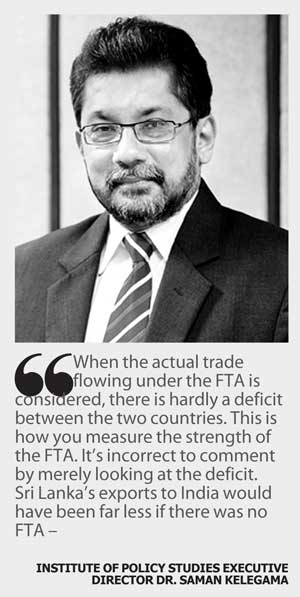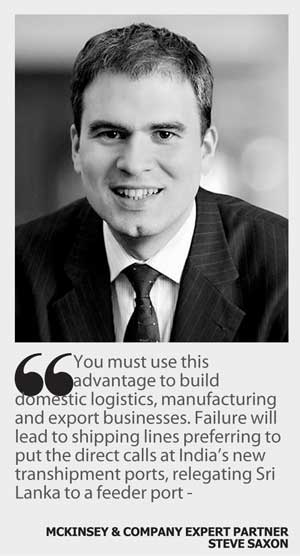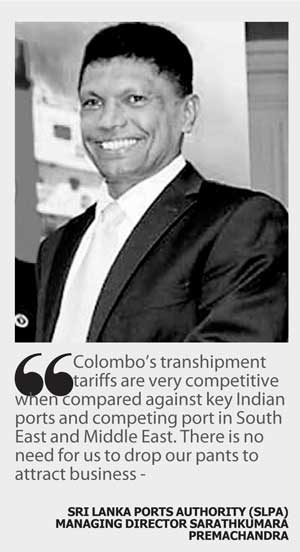05 Aug 2016 - {{hitsCtrl.values.hits}}
 From left: Hayleys Advantis Managing Director Ruwan Waidyaratne, Sri Lanka Ports Authority Managing Director Sarathkumara Premachandra, McKinsey & Company Expert Partner Steve Saxon, Deputy Minister of Foreign Affairs Dr. Harsha de Silva, Institute of Policy Studies Executive Director Dr.Saman Kelegama and TWCorp Chairman Thilan Wijesinghe (moderator)
From left: Hayleys Advantis Managing Director Ruwan Waidyaratne, Sri Lanka Ports Authority Managing Director Sarathkumara Premachandra, McKinsey & Company Expert Partner Steve Saxon, Deputy Minister of Foreign Affairs Dr. Harsha de Silva, Institute of Policy Studies Executive Director Dr.Saman Kelegama and TWCorp Chairman Thilan Wijesinghe (moderator)
By Shabiya Ali Ahlam
International trade and logistics are two important facets of the economy but greater efforts are required to capitalise their potential. It is the key for Sri Lanka’s strategy in becoming a competitive player in the global stage. While measures are being taken to improve these areas, the same level of dedication, commitment and enthusiasm is yet to be seen across all levels was the message that came out of a prolific discussion that took place at the Sri Lanka Economic Summit 2016 this week.
Multiple border crossing puts more emphasis on trade facilitation, and products now pass on as inputs as well as final goods. In that context, efficient customs and port procedures are essential for smooth supply chain operations.
 Veteran economist and Institute of Policy Studies Executive Director Dr. Saman Kelegama noted that with global production networks being dependent on quick, efficient and reliable timeframe in importing and exporting, trade facilitation has developed to be a crucial element in international business.
Veteran economist and Institute of Policy Studies Executive Director Dr. Saman Kelegama noted that with global production networks being dependent on quick, efficient and reliable timeframe in importing and exporting, trade facilitation has developed to be a crucial element in international business.
Link between hub and international trade
According to the World Bank, countries at the same level of per capita income with the best trade facilitation (logistics), experience additional growth of 1 percent in gross domestic product (GDP) and 2 percent in trade.
It is evident that hubs cannot be developed by improving infrastructure alone. A vital component of a hub is liberal trade and investment through a more open economy. Dr. Kelegama noted that since the multilateral trade liberalization process, as determined by the World Trade Organization (WTO), is at a standstill with most countries opting for regional trade agreements (RTAs) and bilateral free trade agreements (FTAs) to pursue more liberal trade. Today, nearly 50 percent of global trade takes place via RTAs, FTAs and others.
Taking the case of Sri Lanka, the trade as a percentage of GDP has declined rapidly since 2004. According to Dr. Kelegama the contraction is largely due to high protection levels in the local economy, which is on the rise since 2004.
It is observed that while tariffs increased slightly over the years, para-tariffs increased significantly.
“In 2009 we became quite protective and this increased even more in 2011. This amongst other factors is one of the major contributors to the decline in international trade in Sri Lanka,” Kelegama said during the discussion that also involved Deputy Minister of Foreign Affairs Dr. Harsha De Silva and Hayleys Advantis Managing Director Ruwan Waidyaratne.
Ways to improve current international trade position
As pointed out many a time before, the obvious way to improve international trade is to boost exports. However, in the recent years, Sri Lanka has seen its exports across a number of sectors move towards a negative trajectory due to both local as well and global challenges.
The economist stressed that the nation can no longer depend “too much” on its traditional markets, which is the US and EU, since both are recovering from a recession. Instead what is essential at this point of time is to look more rapidly at developing markets.
Dr. Kelegama pointed out that for the very need of diversifying into new markets Sri Lanka has to have free trade agreements and deep trade relationship with nations such as China, India, and Singapore, amongst
few others.
 “We need to see these as opportunities and not as threats, “he stated.
“We need to see these as opportunities and not as threats, “he stated.
Nothing to fear
Stating that the trade agreements with the above mentioned countries are all comprehensive economic partnerships, Dr. Kelegama acknowledged that a larger section of the country are of the view that exploring such opportunities would be detrimental to the nation since our economy is significantly smaller compared to the countries it aims at holding hands with.
“This is not correct.Counties entering into such agreements would know how to create the regulatory framework to create a win-win outcome for both, the small as well as the large nation.
“Many small countries have FTAs with large countries. There is the Australia-New Zealand FTA and India-Singapore CEPA. These are only a few. If these countries had the same fear, then they would not have explored such options. Such moves will allow economies, such as ours to reap greater benefits,” assured Dr. Kelegama.
He stressed that the larger country becoming the gainer is avoided by building in Special and Differential Treatment (SDT) in favour of the smaller country. This essentiallyworks out a “win-win” situation for both countries.
“A win-win situation is the best deal for consumers as well as producers in both countries. Asymmetry between the two countries was accommodated by building SDT for Sri Lanka in the India-Sri Lanka FTA,” he said in an attempt to clarify the prevailing misconceptions around the FTAs.
The highly misunderstood Indo – SL FTA
He acknowledged that many opine that the Indo - SL FTA is a “total failure” and the deficit between the two countries is massive. The current view in this regard is that Sri Lanka has not gained a lot. However, Dr. Kelegama noted that statists speak otherwise.
 Sri Lanka’s percentage utilisation of the preferential tariff under the FTA ranges between 60 to 99 percent whereas in India, it is less than 30 percent. In some years it is observed that India’s utilisation has been as low as 4 percent since bulk of the imports that come into Sri Lanka are outside the FTA.
Sri Lanka’s percentage utilisation of the preferential tariff under the FTA ranges between 60 to 99 percent whereas in India, it is less than 30 percent. In some years it is observed that India’s utilisation has been as low as 4 percent since bulk of the imports that come into Sri Lanka are outside the FTA.
Data presented by Dr. Kelegama show that Sri Lanka has used the FTA to a much greater extent than India. It was used at an average of 80 percent compared to India’s 20 percent.
“When the actual trade flowing under the FTA is considered, there is hardly a deficit between the two countries. This is how you measure the strength of the FTA. It’s incorrect to comment by merely looking at the deficit,” he said.
It was stated that one could argue that had the FTA between the two neighbouring countries not been in operation, the deficit would have been larger.
“Sri Lanka’s exports to India would have been far less if there was no FTA,” asserted Dr. Kelegama.
Why convert FTA into CEPA or ETCA?
FTAs have a lifetime and after a certain period they show diminishing returns. This Dr. Kelegama said is prevalent when one looks at the utilisation of the preferential tariffs in the FTA over the years.
From 2003 to 2005, Sri Lanka’s utilisation under the preferential tariffs in the Indo - SL FTA gradually declined and continues to move in that trend. For better use of the FTA, he stressed it is essential for it to be upgraded.
The utilisation decreases due to a number of factors such as lack of supply capacity, meeting Rules Of Origin (ROO) obligations, NTBs/POs, lack of competitive service suppliers and exports of interest being in the negative list in the partner country. Therefore, FTAs should be modified to face the contemporary realities, he advised.
Having stressed the need for an upgrade, it was said the same can be achieved through an ETCA or a CEPA, avenues which Sri Lanka is actively exploring currently.
Dr. Kelegama explained that Economic Partnership Agreements (EPA) basically broaden and widen FTAs. Broadening is done by including services and investment liberalization in the FTAs and widening is done by gradually reducing the negative list and introducing better trade
facilitation measures.
This services liberalization not only increases trade in services, it also increases the competitiveness of the manufacturing products, the economist said.
How so? Recent research by the WTO shows that 29 percent of value addition in manufactured exports of developing countries comes from services. This is also known as ‘servicification’ of the manufacturing sector. It was pointed out that services liberalization will bring down the cost of this particular component, thus helps to improve the overall competitiveness of the manufacturing product as an export or as an import substitute.
Why liberalize investments flows in EPAs/CEPAs/ETCAs?
While the investment-trade nexus is important in pushing trade, the former increases the supply capacity of existing firms and introduces new supply lines.
Dr. Kelegama emphasised that FDI is a key component in stimulating trade and it is FDIs that links small countries to global value chains and global production networks.
“To attract more FDI there needs to be an investment treaty with double taxation agreements, investment protection agreements, IPR laws and others. All these are part of an investment liberalization package,”
he explained.
In EPAs, CEPAs, CECAs, and ETCAs, services and investment liberalization are combined with liberalization in trade in goods to get the best possible results. It is observed that out of the 419 RTAs and FTAs operating at present, 133 have been already converted to CEPAs, CECAs or EPAs. And all have services liberalization component under GATS -Plus and investment liberalization.
Sri Lanka, although a late comer, is now seriously looking at this option.
Rectify the anomalies of the FTA
While some say this is essential, Dr. Kelegama said this assumes that the rest of the world is going to wait till Sri Lanka gets its act together to engage in international trading.
“The tasks must move forward in parallel. No one said first rectify the anomalies in SAFTA and address the NTBs before signing SATIS. After signing an agreement, there is time to agree on which products to liberalize, prepare the schedules in services, and get the regulatory framework in place. The rest of the world is not going to wait for us until we get our act together,” he stressed.
Change in development strategy
As Sri Lanka is witnessing a change of development strategy, it should focus on debt-financed development strategy to exports and FDI-led development strategy, Dr. Kelegama said.
In the export-led strategy, while consolidating market share in existing markets, especially EU and the US, exploring new markets in the growing regions of the world, especially, Asia is essential.
Pursuing the FDI strategy, he advised that in having a focused strategy to attract the same, measures should be taken to exploit the investment-trade nexus via Free Trade Agreements and Regional Trade Arrangements to attract more FDI. Essential is also Trade Facilitation improvement to catalyze trading and link Sri Lanka to global value chains.
“International trade should be used as a key policy instrument in promoting Sri Lanka as a regional hub,” said Dr. Kelegama.
Sri Lanka punches well above its weight
In terms of shipping, McKinsey & Company Expert Partner Steve Saxon opined that Sri Lanka punches well above its weight. It is so since the nation caters to 0.25 percent of the global population, contributes to 0.18 percent of the global trade value and has 12 percent of container shipping tonnage calling at its ports.
“Sri Lanka is actually over 50 times punching weight. Congratulations on the incredible starting point. You are perfectly placed to reap a plethora of benefits,” said Saxon while expressing confidence in Sri Lanka’s potential for further improvements.
He added that Sri Lanka can also benefit from having proportion of the world’s fleet stopping at its ports which is great news. It means connectivity is high. There is direct container line action to 135 cities globally and many of these are with the world’s largest ships.
Transhipment opportunities
Looking at the types of volumes, 75 percent is from transhipment and of that, 70 percent is from and to India. It was noted that for ports that specialize in transhipment, limited inland investments are required since most of the cargo is transhipped from ship to ship with a temporary warehousing at the port facilities. However, the footprint of such transhipment hub terminals have on the local or regional transport system is thus limited. Furthermore, the terminal operator does not have to wait for local or regional transport agencies to provide better accessibility to the terminal, which is often a source of conflict between the port and the city or region.
It was highlighted that transhipment hub can also benefit from being able to handle a significant share of local cargo.
Since transhipment is an activity that does not add any value to the cargo, costs and productivity factors are highly important. Operation costs for transhipment hubs in developing countries tend to be lower, in part due to lower labour costs, particularly if it concerns a new terminal facility.
Saxon stated that since the transhipment business remains highly volatile, transhipment hubs can eventually develop services that add value to the cargo instead of simply moving containers between vessels. According to him, this strategy could trigger the creation of logistics zones within or in the vicinity of the port area, in many cases implemented as a Free Trade Zone.
“This potential capture of added value can help improve the competitiveness of a transhipment hub in view of a general footlessness of transhipment traffic,” he said.
Benefits to Sri Lanka
Reiterating that Sri Lanka has a great position stands to benefit in terms of volumes from India’s rapid consumer and manufacturing growth, Saxon opined this volume makes it cheaper for Sri Lankan importers and exporters.
“You must use this advantage to build domestic logistics, manufacturing and export businesses. Failure will lead to shipping lines preferring to put the direct calls at India’s new transhipment ports, relegating Sri Lanka to a feeder port,” he cautioned
Critical assessment from SLPA
While a good majority continue to harp of Sri Lanka’s strategic location, Sri Lanka Ports Authority (SLPA) Managing Director Sarathkumara Premachandra was more critical in this regard.
According to him, geographic location was attractive yesterday, and close proximity to sea routes can just be one useful factor.
“Location is of no use if the right connections to the markets are not available, right capacity is not provided ahead of demand and most importantly if the right management and systems are not provided and if appropriate cost structure is not facilitated,” he charged.
Inter-terminal and inter-port competition
Pointing out the good, bad and the ugly in this regard, he said good is that the competition between operators would be on quality, and on technology advancement.
The bad on the other hand is that individual goals take priority and “cannibalization” is the apparent strategy. In that sense the goals of the port and the country takes a second priority, leading to low utilisation of port facilities, which in turn results in artificial congestion.
The ugly according to him is that price becomes a tool of competition and shipping lines setting one terminal against the other. While the overall profitability of the port sector suffers, new investors are discouraged due to low revenue and high price competition.
With regard to inter port competition, Premachandra assured that quality of service is on par with any competitor. Facilities continue to grow and prices remain highly competitive.
“Colombo’s transhipment tariffs are very competitive when compared against key Indian ports and competing port in South East and Middle East. There is no need for us to drop our pants to attract business,” he quipped.
Way forward
According to the SLPA MD, the national port master plan is a priority and there would be no more ad-hoc creations. In the battle between state owned and private terminal operators, port regulatory mechanism will remain a priority irrespective of ownership.
He stressed for better management, SLPA must be institutionally restructured to take on port development. Furthermore, broad base of the market is important since total dependence on sub-continent is not healthy.
“Capacity optimization is a must and the port should act as one terminal. We must realise that our competitors are monopolies. Capacity building should not be based on demand and it is imperative to understand that this is a supply driven market,” said Premachandra.
“Hub business is a gamble. Once in there is no return, big winners are the biggest gamblers. If we do not grow to meet the competition we will perish,” he added.
29 Nov 2024 28 minute ago
29 Nov 2024 47 minute ago
29 Nov 2024 2 hours ago
29 Nov 2024 3 hours ago
29 Nov 2024 3 hours ago